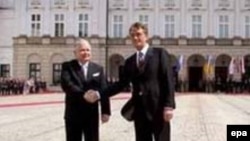One of the darker stains of that legacy is represented by the village of Pawlokoma, where ethnic Ukrainian inhabitants were killed by a Polish military group in 1945. The Ukrainian and Polish presidents will attempt to come to terms with that tragedy by unveiling a memorial to the victims during their visit.
Today, Pawlokoma is home to about 500 residents in southeastern Poland, 50 kilometers from the Polish-Ukrainian border. But prior to the outbreak of World War II, the Polish village boasted a population of 1,200 -- about 900 Greek Catholic (Uniate) Ukrainians living among Roman Catholic Poles.
Mass Killing
In March 1945, a detachment of Polish anti-Nazi guerrillas from the Home Army (AK) subordinated to the Polish emigre government in London shot to death hundreds of Ukrainian inhabitants of Pawlokoma. The Ukrainians were herded in a local Greek Catholic church, interrogated and likely tortured, and then taken to a local cemetery where they were executed.
Yushchenko and Kaczynski will travel on May 13 to Pawlokoma to unveil a memorial dedicated to that tragic event. An inscription on the memorial places the number of victims of the 1945 massacre at 365.
However, this figure is questioned by some Polish historians, including Zdzislaw Konieczny.
Konieczny -- who lives in the Polish town of Przemysl, some 40 kilometers from Pawlokoma -- is the author of a book on the Pawlokoma massacre. According to him, the AK group killed some 150 Ukrainian men in Pawlokoma -- while women and children were spared and ordered to march to Ukraine.
Konieczny argues that the massacre was retaliation for numerous killings of Poles from Pawlokoma and neighboring villages carried out by the Ukrainian Insurgent Army (UPA).
The UPA was created by the Organization of Ukrainian Nationalists (OUN) in Nazi-occupied Ukraine in 1942. The armed force pursued the ideal of an independent Ukraine, which led it to fight Polish, Soviet, and Nazi forces at various times.
Violent Retaliation
Konieczny said in an interview with the Polish daily "Nasz Dziennik" on May 10 that the immediate motive behind the massacre was the abduction by the UPA of a dozen Poles from Pawlokoma in January 1945. The then-Polish communist police in the area, according to Konieczny, were too weak to react to the capture, while Soviet troops were not trusted by the local population.
"In this situation the Polish pro-independence underground decided to conduct a retaliatory action in Pawlokoma, which had been known for anti-Polish manifestations. The purpose of [this action] was to warn the OUN-UPA that Poles would not tolerate its further attacks against and killings of the Polish population in Pawlokoma and neighboring villages," Konieczny told "Nasz Dziennik."
Petro Potichny, a Ukrainian emigre historian and UPA veteran, wrote a book on Pawlokoma in which he traced the history of the village back to the 15th century.
Poland's current eastern border with Ukraine and Belarus lies roughly along the Curzon Line. It originated as a demarcation line proposed in 1919 by the British foreign secretary, Lord Curzon, as a possible armistice line between Poland and Bolshevik Russia during the then-Polish-Soviet war.
Potichny told RFE/RL that the Pawlokama massacre reflects a wider pattern of the behavior of Poles toward Ukrainians during World War II along the ethnic Ukrainian-Polish borderland on both sides of the Curzon Line.
"It was not an isolated episode. It was, so to say, a [purposeful] policy of the Polish nationalist underground," Potichny said. "But not only that of the nationalistic underground. The communist authorities, too, did similar things. They primarily intended to finally remove Ukrainians from these lands. Therefore, Pawlokoma is just a symbol of all that."
But Potichny admits that Ukrainians, too, were responsible for the murderous Ukrainian-Polish war fought by the UPA and the AK during the Nazi occupation and afterward.
"If one is to attribute blame, one needs to say that the Ukrainians are mostly to blame for what took place east of the Curzon Line, while the Poles are mostly to blame for what took place west of this line," Potichny said.
History Of Reconciliation
In July 2003, the then-presidents of Ukraine and Poland -- Leonid Kuchma and Aleksander Kwasniewski, respectively -- met in the village of Pavlivka in the Ukrainian region of Volhynia to commemorate ethnic Poles murdered by the UPA in 1943. Kuchma and Kwasniewski unveiled a memorial to several hundred Poles killed by the UPA in that particular village.
The postwar period only added to the Polish-Ukrainian record of mutual wrongs and prejudices. In 1947, the Polish communist government forcibly resettled some 140,000 Ukrainians from their native areas in southeastern Poland to Poland's newly acquired northern and western territories. The official excuse for that mass expulsion was the desire to undercut the social base of support for the UPA in the area.
Closing Arguments
Will the Ukrainian and Polish governments manage to transfer their official determination to reconcile both nations over their history to ordinary Ukrainians and Poles? This may prove to be a tricky task. But as Polish historian Bogumila Berdychowska from Warsaw told RFE/RL, this task, if completed, could beneficially invigorate the development of Polish-Ukrainian relations, which in other respects are now almost exemplary.
"Closing historical accounts is very important for present-day politics," Berdychowska said. "The relations between independent Ukraine and Poland testify to one thing: There are no principal disagreements as regards contemporary politics [between the two countries]; there are no principal disagreements as regards economic relations. Actually, the only source of conflicts lies in history."
In 2002, Kwasniewski officially condemned the forcible resettlement of Polish Ukrainians by the communist authorities in 1947. Poles expected that Kuchma in 2003 would respond with an official apology for the wartime massacres of Poles in Volhynia. But Kuchma did not fulfill that expectation.
One should not expect any official apologies from either Yushchenko or Kaczynski in Pawlokoma. However, their meeting there seems to be a significant, even if small, step toward Ukrainian-Polish reconciliation.
(Natalia Tchourikova of RFE/RL's Ukrainian Service contributed to this report.)
Remembering The Holocaust
 Children from the Auschwitz death camp when it was liberated in 1945 (epa)
Children from the Auschwitz death camp when it was liberated in 1945 (epa)
Ceremonies were held around the world on January 27 to remember the victims of the Holocaust. It's the first international day commemorating the mass murder of Jews during World War II, and it falls on the anniversary of the 1945 liberation of the Nazi death camp at the site of the Auschwitz-Birkenau death camp in Poland. RFE/RL correspondent Kathleen Moore has assembled an audio portrait for the occasion, in which you'll hear voices of camp survivors, as well as sounds from the 60th anniversary commemorations at Auschwitz last year. It starts with the screech of brakes, recalling the trains that once took people to their deaths at Auschwitz.
Listen to the complete audio portrait (about three minutes):
Real Audio
Windows Media
Train braking
Music and singing from 60th anniversary ceremony
Survivor Anita Lasker-Wallfisch in English: "We knew what was going on in Auschwitz, so it was a matter of preparing yourself to be stuck in a gas chamber."
Survivor Halina Kastrytskaja in Russian: "A train with Jews had arrived just before our train came [to the camp]. As the train with the Jews was unloaded they were taken straight to the crematorium."
Archive news announcer in English: "…the Nazi plan for the physical extermination of the Jews known as the Final Solution of the Jewish problem...."
Survivor Kurt Goldstein in English: "Three years that I passed in this camp which was a hell on earth."
Survivor Roman Kent in English: "How can one document the smell of burning flesh which filled the air? How can one describe the living skeletons, still alive, just skin and bones?"
Waldemar Dabrowski, Polish culture minister in 2005, in Polish: "We are on the site of the most gigantic cemetery in the world, a cemetery where there are no graves, no stones, but where the ashes of more than 1.5 million beings lie."
U.S. Vice-President Dick Cheney in English: "On this day in 1945, inside a prison for the innocent, liberators arrived and looked into the faces of thousands near death."
Russian President Vladimir Putin in Russian: "We bow our heads before the victims of the Holocaust, before all the victims of the inhumane war unleashed by Nazism. We mourn them and remember the immortal feat of the anti-Hitler coalition."
Unidentified female survivor in Polish: "Never -- never will this happen again."
Israeli Nobel Peace Prize winner Elie Wiesel in English: "If you, after this day, will be the same, then we have lost an encounter with this memory which you are now the custodians of, it must do something to you and through you the whole world and put an end to the curse of hatred and the scourge of anti-Semitism, racism, bigotry, hatred.''
United Nations Secretary-General Kofi Annan in English: "The evil that destroyed 6 million Jews and others in those camps is one that still threatens all of us today. Every generation must be on its guard to make sure that such things never happen again."
Paul Wolfowitz, then U.S. deputy defense secretary, in English: "Never again and never forget."
(compiled from RFE/RL interviews and archive materials)
 A women's barracks at Auschwitz in 1945 (epa)
A women's barracks at Auschwitz in 1945 (epa)
Related Articles:
Memorial Service Held In Vienna For Nazi Hunter Wiesenthal
Children In Former Soviet Union Know Little About Holocaust
Post-Holocaust World Promised 'Never Again' -- But Genocide Persists

To view a microsite devoted to RFE/RL's coverage of the 60th anniversary of the end of World War II, click here.










